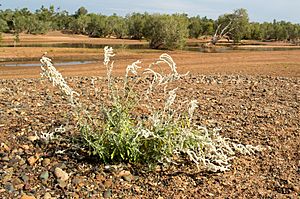Kapok bush facts for kids
Quick facts for kids Kapok bush |
|
|---|---|
 |
|
| Scientific classification | |
| Genus: |
Aerva
|
| Species: |
javanica
|
| Synonyms | |
|
Achyranthes javanica Pers. |
|
The Aerva javanica, also known as the kapok bush or desert cotton, is a type of plant from the Amaranthaceae family. You can find this plant growing naturally in many parts of Africa, including Madagascar. It also grows across southwest and south Asia. This plant has even started to grow in northern Australia, where it wasn't originally from.
Contents
What Does the Kapok Bush Look Like?
The kapok bush is a soft plant with many stems and broad leaves. It often grows straight up, reaching about 1.6 meters (around 5 feet) tall. In places like Western Australia, it likes to grow in sandy soils. You'll often see it along areas where water flows, like small creeks or drainage lines.
When Does it Flower?
This plant usually flowers between January and October. Its flowers are often thick and white.
How Does the Kapok Bush Reproduce?
The kapok bush has a special way of making new plants. It uses a process called agamospermy. This means that the plant can create seeds without needing to be fertilized. The new plants that grow from these seeds are exact copies, or clones, of the parent plant.
The kapok bush also has separate male and female plants. This means that male flowers grow on one plant, and female flowers grow on a different plant. This is called being dioecious. The plant also uses a special way to make its food, called C4 carbon fixation.
Why is the Kapok Bush Important?
This herb has very deep roots. Because of this, it's often used to help hold soil in place, especially in desert reclamation projects. This helps stop the sand from blowing away.
Traditional Uses
People use the kapok bush for many things. It can be used as fuel for fires. It's also a good food source for animals like goats. In traditional medicine, some people believe that the seeds can help cure headaches. A special rinse made from the plant is sometimes used to try and treat toothaches.
Modern and Indigenous Uses
In northern Australia, the kapok bush has become a natural part of the environment. Local indigenous peoples have used and grown this plant for a long time. In Arabia, the thick, white flowers were traditionally gathered. They were used to stuff cushions and pads for saddles. Even today, the soft fibers are still used like kapok to fill pillows. The Yindjibarndi and Ngarluma people call it Bilhangga. In English, it's known as the Kapok Bush.
See also
 In Spanish: Aerva javanica para niños
In Spanish: Aerva javanica para niños


